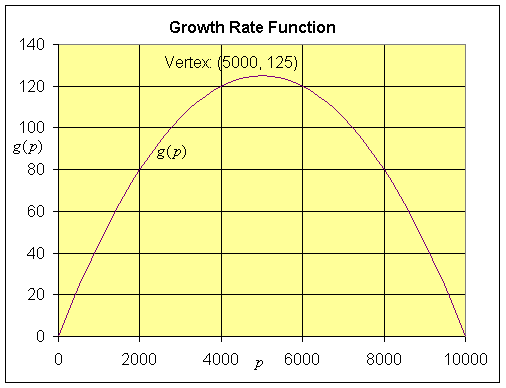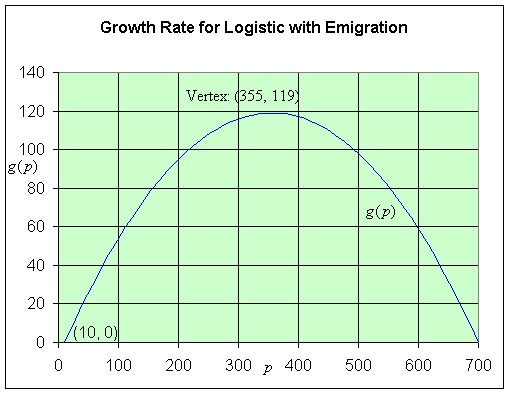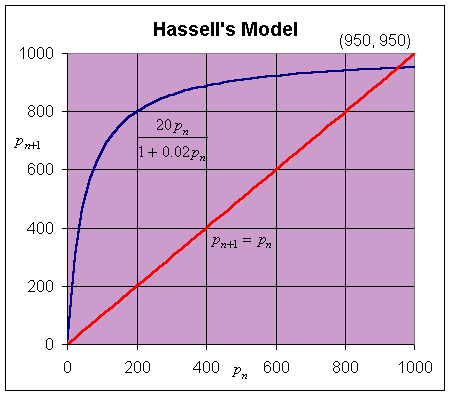Math 121 - Calculus for Biology I
Spring Semester, 2001
Logistic Growth - Worked Examples
San Diego State University -- This page last updated 03-Apr-01
|
|
Math 121 - Calculus for Biology I |
|
|---|---|---|
|
San Diego State University -- This page last updated 03-Apr-01 |
![]()
Logistic Growth - Worked Examples
Example 1 (Logistic Growth model): Consider the logistic growth model given by the equation
where n is measured in weeks. Assume that p0 = 200 and find the population for the next three weeks, p1, p2, and p3.
Find all equilibria for this model. Sketch a graph of the updating function (the right hand side of the equation above) along with the line pn+1 = pn, showing clearly on the graph the equilibria and the vertex of the parabola.
Solution:
To find the populations for the next three weeks, we begin by substituting the given value for p0 into the growth model equation.
p2 = 1.2(224) - .0004(224)2 = 248.7
p3 = 1.2(248.7) - 0.0004(248.7)2 = 273.7
From the lecture, we know that pe = 0 (the trivial solution), or pe = M. At equilibrium points the above model is
-0.2pe + 0.0004pe2 = 0
pe(0.0004pe - 0.2) = 0
Thus, the equilibrium points occur at pe = 0 or pe = 0.2/0.0004 = 500.
Below is a graph of the updating function, showing the vertex of the parabola and the points of intersection of the updating function with the identity function, which gives the equilibria (one being the origin, not labeled).

Example 2 (Growth Rate function): An alternate way to look at discrete population growth models is to consider the population at the (n+1)st generation as being equal to the population at the nth generation plus the growth of the population, g(pn), between the generations. Consider the logistic growth model given by the equation
where n is measured in hours. The equilibria can be readily found by determining when the growth rate is zero.
a. Assume that p0 = 500 and find the population for the next three hours, p1, p2, and p3.
b. Find the p -intercepts and the vertex for
Sketch a graph of g(p).
c. By finding when the growth rate is zero, determine all equilibria for this model.
Solution: a. We find the first three iterations by substituting each successive value into the given updating function. Thus,
p2 = 524 + 0.05(524)(1 - 0.0001(524)) = 549,
p3 = 549 + 0.05(549)(1 - 0.0001(549)) = 574.
b. Since g(p) = 0.05 p(1 - 0.0001p), the p-intercepts are found by solving g(p) = 0.05 p(1 - 0.0001p) = 0, which gives either p = 0 or 1 - 0.0001p = 0. The latter is equivalent to p = 10,000. The vertex occurs halfway between the p-intercepts, so p = 5,000 and g(5000) = 0.05(5000)(1 - 0.0001(5000)) = 125.
The graph of g(p) is a standard parabola, which is shown below showing the p-intercepts and the vertex.

c. From the graph above, it is clear that the growth rate is zero at 0 and 10,000, so the equilibria occur at pe = 0 and 10,000.
Example 3 (Logistic Growth with Emigration): We extend the previous example to include the possibility that the population might be affected by immigration or emigration. Suppose that the growth rate for a population is given by
This says that between each generation there is a 71% growth rate, while 0.001pn2 are lost due to crowding and 7 emigrate. The discrete dynamical model for this population model is given by
where n is measured in generations.
a. Assume that p0 = 100 and find the population for the next three generations, p1, p2, and p3.
b. Find the p -intercepts and the vertex for g(p) and sketch a graph of g(p).
c. By finding when the growth rate is zero, determine all equilibria for this model.
Solution: a. As we did in the previous example, we iterate this discrete logistic model with emigration to obtain the next three generations. Thus,
p2 = 154 + 0.71(154) - 0.001(154)2 - 7 = 233,
p3 = 233 + 0.71(233) - 0.001(233)2 - 7 = 337.
b. Since g(p) = 0.71 p - 0.001p2 - 7 = -0.001(p2 - 710p + 7000), the p-intercepts are found by solving g(p) = -0.001(p2 - 710p + 7000) = -0.001(p - 10)(p - 700) = 0, which gives either p = 0 or p = 700. The vertex occurs halfway between the p-intercepts, so p = 355 and g(355) = -0.001(345)(-345) = 119.
The graph of g(p) is a parabola, which is shown below showing the p-intercepts at p = 10 and 700 and the vertex.

c. From the graph above, it is clear that the growth rate is zero at 10 and 700, so the equilibria occur at pe = 10 and 700.
Example 4 (Hassell's model): There is no reason that the discrete dynamical model should have a quadratic form and in fact, because a quadratic function goes negative for large values of p, this model becomes very unrealistic. Hassell modified this growth model (especially for insect populations) to use a rational function response (a rational updating function).
Consider the discrete dynamical model given by the equation

where n is measured in generations.
a. Assume that p0 = 200 and find the population for the next four generations, p1, p2, p3, and p4.
b. Find the p -intercepts and the horizontal asymptote for H(p) and sketch a graph of H(p) for p > 0. (Note that the vertical asymptote occurs at p = -50, which is outside the biologically valid range as p should be greater than or equal to 0.)
c. By solving pe = H(pe), determine all equilibria, pe, for this model.
Solution: a. Once again, we iterate this nonlinear dynamical model by Hassell by substituting the value of p0 = 200 into the model. The result is




b. The only intercept for H(p) is (0, 0), while the horizontal asymptote is H = 1000. Below is a graph of Hassell's updating function along with the identity map. The intersections give the equilibria.

c. The equilibria are found by setting pe = pn+1 = pn, so we solve

One solution is clearly pe = 0. Next we multiply both sides by (1 + 0.02 pe)/pe, which gives
Solving this equation gives the other equilibrium, pe = 950.